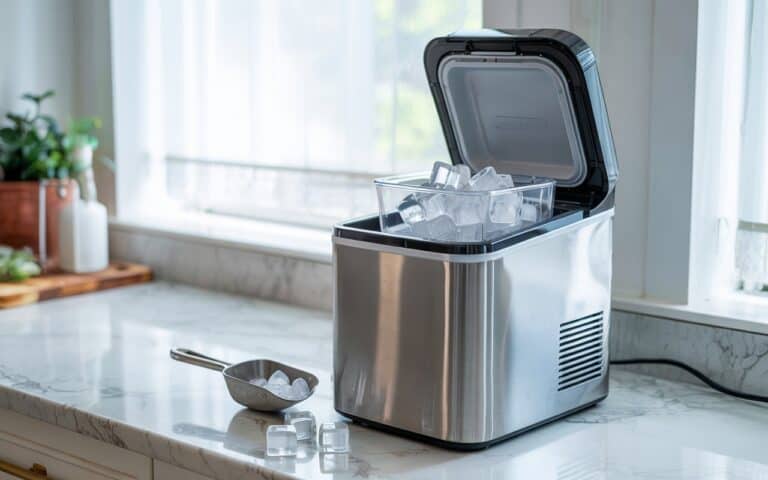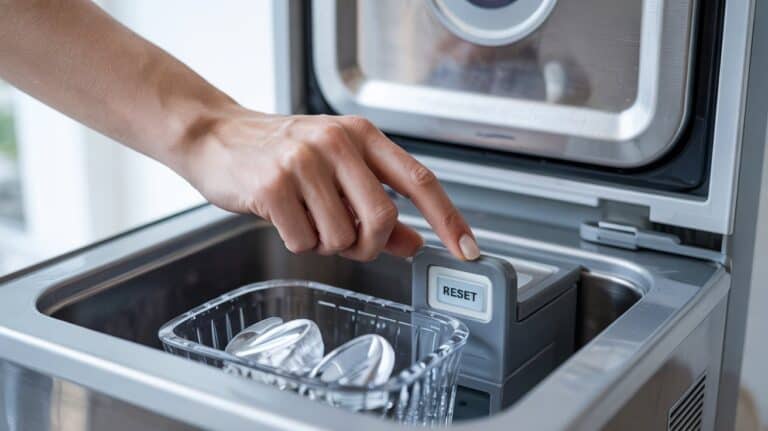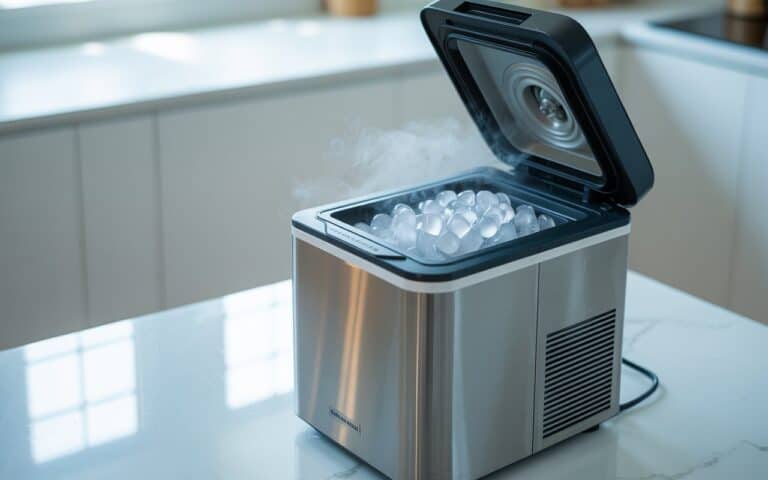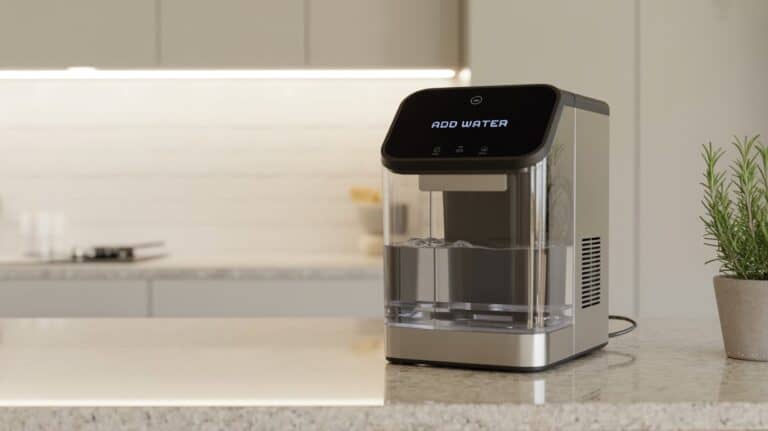Types of Ice Makers (A Complete Guide to Every Model & Use)

Not all ice makers are created equal — and picking the wrong type can leave you frustrated with slow ice, poor storage, or the wrong shape altogether.
Whether you’re looking for a compact kitchen ice maker, a commercial machine for your bar, or something in between, understanding the different types of ice makers is key to choosing the right one.
In this complete guide, we’ll break down every major ice machine type—by design, by the kind of ice it makes, and by where it works best. You’ll learn the pros and cons of each, what they’re really good for, and how to decide which one fits your daily needs.
Let’s get into the world of ice maker types—because trust us, it’s not just about making ice. It’s not just about making ice – it’s about getting the right kind of ice, from the right machine.
That’s exactly why not all ice makers are the same — and why choosing carefully matters.
Ice Makers by Design (6 Core Types)

1. Portable Ice Makers
Portable ice makers are the most beginner-friendly and budget-friendly machines on the market. They’re compact, lightweight, and require no water line or complicated installation — just plug them in, fill the tank, and you’ll have ice in about 6 to 10 minutes.
These machines are perfect for casual use in small kitchens, dorm rooms, RVs, or even for taking on weekend trips. Most produce bullet-shaped ice and can make anywhere from 20 to 35 pounds of ice per day, depending on the model.
But keep in mind: portable doesn’t mean storage. These machines don’t keep the ice frozen for long — once it melts, it drips back into the tank to be reused. They also tend to be a bit noisy and aren’t ideal for serving large groups continuously.
Best for: People who want quick ice in a pinch, have limited space, and don’t need long-term ice storage.
🔎 Personal note:
I’ve used a portable ice maker during a summer cabin trip, and while it was super convenient, we had to stay on top of emptying the bin often since the ice would melt quickly.
2. Countertop Ice Makers
While they’re often confused with portable models, countertop ice makers tend to offer more power, more capacity, and a more refined design. They still sit on your counter and don’t need a permanent water connection — but they feel like a serious upgrade from the lightweight, travel-friendly versions.
Most countertop models come with a larger water tank, quieter operation, and faster ice cycles — some producing a fresh batch every 6 minutes. Many also include a small storage bin that keeps ice cold for a bit longer, though they still don’t function like freezers.
This type is ideal for home users who want daily, hassle-free ice without committing to a built-in setup. They fit neatly under cabinets, look sleeker in the kitchen, and handle the needs of a small family with ease.
Best for: Homeowners, apartment dwellers, and anyone who wants better performance without full installation.
3. Undercounter Ice Makers
If you’re regularly running out of ice — or you’re hosting more than just a couple of guests on the weekend — it might be time to step things up with an undercounter ice maker. These machines are built to fit seamlessly beneath your kitchen or bar counter, offering a steady supply of ice without taking up surface space.
They usually produce much more ice than portable or countertop models — often 50 pounds or more per day — and many come with a dedicated freezer compartment to keep the ice solid until you need it. That means no more melting-and-recycling loop.
Unlike freestanding ice makers, undercounter units are designed to blend in. They’re meant to be installed into cabinetry, so they feel more like an appliance than a machine you just set down. But that also means installation is a bit more involved — many models require a water line and a drain system (gravity or pump).
Best for: Busy families, or anyone tired of constantly refilling trays or waiting for another ice cycle.
4. Built-in / Freestanding Ice Makers
At first glance, built-in and freestanding ice makers might look the same — similar size, similar output — but how and where they’re installed makes a big difference.
Built-in ice makers are designed to be installed flush with cabinetry. They have front-facing vents, so they don’t need extra breathing room on the sides. This makes them perfect for seamless kitchen designs, home bars, or RV setups where every inch matters.
On the other hand, freestanding ice makers are more flexible. You can place them anywhere with access to water and drainage — even in a garage or outdoor kitchen. But they need ventilation space on the sides or back, and they often take up more visual space since they’re not meant to “disappear” into cabinetry.
When it comes to installation, freestanding models are generally easier: plug them in, connect the water line, and you’re good to go. Built-ins may require custom cabinet fitting and more precise drainage alignment.
And speaking of drainage — this is a big deal. Some machines rely on gravity drain systems, which require placing the unit near a floor drain. Others use a built-in pump, allowing for more flexible placement, especially in homes where gravity drainage isn’t an option.
Best for:
➤ Built-in → Sleek, permanent kitchen or bar installations.
➤ Freestanding → Flexible placement with less setup hassle.
5. Refrigerator Ice Makers
If your fridge has a built-in ice maker, congrats — you already own one of the most convenient types of ice machines out there. Refrigerator ice makers are common in modern kitchen setups, especially side-by-side or French door models. They’re perfect for day-to-day use and don’t take up extra space.
There are two main styles:
– Automatic units that refill themselves whenever the ice bin runs low
– Manual ones where you have to activate the cycle or refill water manually (less common, mostly in budget or compact fridges)
Most of these machines produce crescent-shaped or half-moon ice, which is good enough for drinks and everyday use — but not ideal if you’re picky about ice clarity, shape, or chewability.
The downside? These ice makers usually have a limited output and small storage bins. So if you’re hosting guests or need a constant flow of ice, they’ll fall short quickly.
Best for: Everyday kitchen use, especially for families who just want convenient ice without buying a separate machine.
6. Commercial Ice Makers
When volume matters, commercial ice makers step in. These machines are built for serious production — think restaurants, coffee shops, hotels, or any business that needs a steady, high-capacity supply of ice. Some can churn out over 300 pounds per day, easily outpacing anything you’d use at home.
There are two main formats to choose from:
- Modular units, which are just ice-producing heads — they need to be paired with a separate storage bin. These are great for businesses that go through a lot of ice fast, since you can choose bin sizes based on your needs.
- Self-contained units, which combine both the ice maker and the storage bin in one body. Easier to install, more compact, but typically hold and produce less ice.
You’ll also find two major cooling systems:
- Air-cooled machines are more energy-efficient and easier to maintain but need good ventilation around them.
- Water-cooled machines are quieter and better for hot environments, but they consume more water and may be restricted in certain areas due to regulations.
Choosing the right commercial model depends on where it’ll be used, how much ice you need per day, and what kind of ice you’re serving — clear cubes for cocktails? flake ice for displays? nugget ice for drinks?
Best for: Businesses with consistent customer flow, especially in food service, hospitality, or healthcare.
Portable vs Undercounter vs Freestanding
Not sure whether a portable, undercounter, or freestanding ice maker fits your needs? These three styles often get compared — especially when buyers are trying to balance size, power, and convenience.
Here’s a quick side-by-side comparison to help you understand the major differences:

Types of Ice Cubes (And the Machines That Make Them)
Not all ice is created equal — and if you’ve ever chewed on nugget ice or tried to chill a drink with gourmet cubes, you know exactly what that means.
The type of ice you get affects everything: how fast your drink chills, how long it stays cold, and even how satisfying it feels in your mouth.
In this section, we’ll break down the most common ice cube types, what they’re best for, and which machines make them — so you can match your taste (literally) with the right machine.

Bullet Ice
Bullet ice is one of the most common — and most underrated — ice types out there. It’s named after its shape: small, round-edged cylinders with a hollow center, kind of like a bullet or a short tube. Because of that shape, bullet ice melts faster than solid cubes, but it also chills drinks quickly.
The texture is soft enough to chew without breaking your teeth, but not quite “chewable” like nugget ice. It’s a favorite for casual use — in water bottles, sodas, iced coffee, and anywhere you need fast ice that works without fuss.
Most portable ice makers and many countertop units produce bullet ice by default. It’s the go-to choice when speed, simplicity, and affordability are more important than fancy shapes.
Best for: Everyday home use, office kitchens, dorm rooms, and RVs — anyone who wants quick, decent ice without overthinking it.
Nugget (Chewable) Ice
Known by fans as “Sonic ice”, nugget ice is soft, airy, and incredibly chewable. It’s made by compressing flaked ice into small, textured pellets — perfect for snacking, sipping, or crunching between sips.
What makes nugget ice special isn’t just its texture — it absorbs flavor, holds up well in drinks, and is surprisingly satisfying to chew. It’s the top pick for smoothies, iced teas, and fountain drinks.
You’ll usually find nugget ice in higher-end countertop machines and specialty nugget ice makers, many of which cost more than typical home models — but the loyal fanbase says it’s worth every penny.
Best for: Ice lovers, anyone who enjoys chewing ice, and homes that want that “Sonic drink experience” on demand.
Crescent Ice
Crescent ice has a distinct half-moon shape that’s flat on one side and curved on the other — kind of like a little ice smile. It’s engineered to be space-efficient inside storage bins, and it doesn’t clump together like traditional cubes.
Thanks to its solid, slow-melting build, crescent ice works great in environments where drinks need to stay cold longer — like sit-down restaurants, cafeterias, or waiting areas. It also slides easily into narrow glasses and dispensers.
You’ll typically find it in refrigerator ice makers and some undercounter models, especially in older or mid-range appliances that prioritize function over fancy shapes.
Best for: Long-drink sessions, office break rooms, and anyone who wants practical ice that doesn’t melt in five minutes.
Clear Ice
Clear ice stands out for its crystal clarity — it looks elegant and melts slower than regular cloudy ice. This is because it’s made without trapped air or minerals, resulting in solid, high-quality cubes that cool drinks effectively without watering them down too quickly.
It’s produced using a slow directional freezing process that pushes out air bubbles and impurities. Some advanced machines can do this automatically, while others may require manual methods like freezing in layers.
You’ll often find clear ice in high-end home ice makers or professional settings where appearance and performance matter — such as events, hospitality areas, or premium food service.
Best for: Guests, events, offices, and anyone who prefers pure, long-lasting ice with a polished look.
Flake Ice
Flake ice is soft, light, and breaks apart easily — almost like tiny, snowy shards. It’s made by scraping thin layers of ice off a cold surface, which creates soft, uneven pieces that mold around whatever they touch.
Because of its texture, flake ice is ideal for displaying fresh food — like seafood, salads, or cold buffets — and is often used in healthcare and medical settings where a gentle, moldable ice is needed.
This type of ice melts faster than solid cubes, so it’s not great for drinks — but it’s perfect for cooling and presentation. Most flake ice requires specialized commercial machines, which are built for high-output environments.
Best for: Food displays, catering services, and medical applications where flexibility and surface coverage matter.
Gourmet (Top-Hat) Ice
As the name suggests, gourmet ice is all about presentation. These cubes are large, clear, and shaped like a top hat — wide at the base, narrow at the top. They’re designed to look premium and melt slowly, making them ideal for settings where style and detail matter.
You’ll usually find this ice in upscale hotels, lounges, or catered events — not because it performs dramatically better, but because it adds a sense of polish and refinement. The slow melt also means less dilution over time.
However, machines that make gourmet ice are typically expensive, slower, and more complex to maintain. They’re built for environments where image is part of the experience, not just function.
Best for: High-end food service, formal events, and anyone who values appearance as much as performance.
How to Choose the Right Ice Maker (Simple Questions)

1. Where will you use it?
The location you plan to use your ice maker makes a huge difference — not just in size, but in features, setup, and durability.
- Home kitchens: Countertop or refrigerator ice makers are often enough. They’re compact, quiet, and easy to maintain for daily use.
- RVs and travel: Go with a portable ice maker. It doesn’t need a water hookup, and it starts making ice fast — perfect for camping or road trips.
- Hosting & large families: You’ll need something with more capacity. Undercounter or freestanding models are great for serving guests or keeping up with higher daily use.
- Offices: Quiet machines with consistent output work best. Countertop nugget models or built-in units are ideal, especially if multiple people will use them throughout the day.
- Restaurants or cafés: Don’t compromise — only commercial ice makers will keep up with demand. Look for modular or self-contained machines based on your space and volume.
💡 Quick Tip:
Match your space + power access with the type of machine. Not every kitchen or workspace is ready for a drain line or built-in install — sometimes plug-and-play is all you need.
2. How much ice do you need per day?
Your daily ice needs are one of the most important factors in choosing the right machine. Not all ice makers produce or store the same amount — and going too small can leave you constantly waiting on the next batch.
- Light use (10–30 lbs/day): Perfect for individuals, couples, or occasional use. Portable and countertop models usually fall in this range.
- Moderate use (30–60 lbs/day): Best for small families or workplaces with a few people. Some high-end countertop machines and compact undercounter models can handle this.
- Heavy use (60+ lbs/day): For larger households, offices, events, or small food businesses. This is where freestanding and commercial ice makers shine.
💡 Tip:
Always plan for a bit more than you think you need — especially if you host guests often or use ice for food prep and storage.
3. Do you care about ice shape?
It might sound like a small detail — but ice shape affects everything from how fast your drink cools, to how long it stays cold, to how enjoyable it feels to chew.
- Bullet ice: Fast, soft, and great for daily use. Found in most portable and countertop machines.
- Nugget ice: Chewable and satisfying — a favorite for iced drinks and people who love to snack on ice.
- Crescent ice: Space-saving and slow-melting. Common in refrigerator units.
- Clear or gourmet cubes: Dense, pure, and melt very slowly. Best for guests, display, or when appearance matters.
Choosing the right shape can improve your overall experience — and some people won’t settle for anything less than their favorite texture.
4. Do you want fast or quiet?
Speed and noise often go hand-in-hand. Faster machines tend to be louder, while quieter ones usually trade speed for smoother operation.
- Portable units: Typically the fastest — but also the noisiest. You’ll hear fans, pumps, and the clinking of fresh ice every few minutes.
- Undercounter and built-in machines: Quieter and more stable, especially in kitchens or office settings where noise matters.
- Commercial units: Volume and noise can vary — some are built for quiet operation, others prioritize output.
If you’ll place your machine in a shared space or use it late at night, quiet performance might be worth prioritizing over raw speed.
5. Manual refill or automatic?
Portable and countertop models need manual refilling — you pour water in yourself.
Undercounter, freestanding, and commercial units often connect to a water line for automatic refills — more convenient, less hassle.
6. What’s your budget?
- $100–$200 ➤ Portable units
- $200–$500 ➤ Countertop or small undercounter
- $500+ ➤ Freestanding and built-in models
- $1500+ ➤ Commercial-grade machines
The more you pay, the more you get: better build, more ice, and less effort.
FAQs – Answering the Web’s Most Common Questions
Q: What kind of ice maker is best for home use?
A: Countertop ice makers are best for most homes — compact, easy, and fast.
Q: What type of ice maker makes nugget ice?
A: Only machines labeled as “nugget” or “chewable” ice makers can do that.
Q: What’s the difference between ice maker types and ice cube types?
A: Ice maker = machine style.
Ice cube = shape/texture of the ice it produces.
Q: Why do restaurants use different machines?
A: Because they need more ice, faster — and often specific shapes for food or drinks.
Q: What type of water is best for ice makers?
A: Clean, filtered water is ideal. Avoid hard or mineral-heavy tap water.
Q: How long does ice stay frozen in a portable ice maker?
A: About 20–30 minutes — it melts quickly unless transferred to a freezer.
Final Thoughts
Choosing the right ice maker isn’t just about the shape or size — it’s about matching the machine to your real needs. Whether you’re outfitting your kitchen, setting up for travel, or simply tired of refilling trays, there’s a machine that fits your routine perfectly.
Before you decide, think about where you’ll use it, how much ice you actually need, and what type of ice feels best to you. Some people care about speed, others care about texture — and some just want a machine that works without hassle.
Still figuring things out?
We’ve got you covered. From deep reviews to simple how-tos, you’ll find everything you need to compare models, clean your current machine, or fix that annoying “add water” error.
Your ice game is about to level up.






